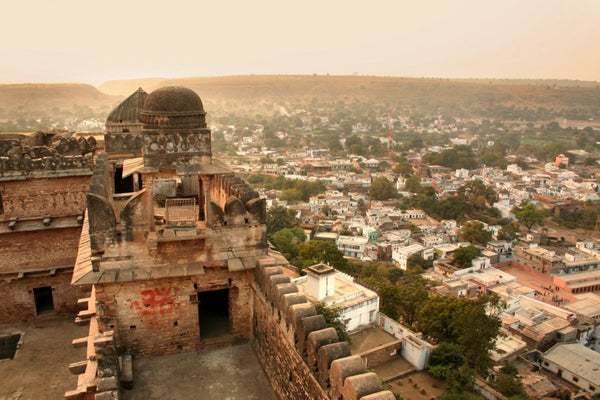Chanderi, which is amongst the best known handloom clusters, occupies a special place because of its centuries old weaving specialty of producing finely textured fabrics of silk and cotton embellished with zari woven work, and more specifically because of its saris that have been patronized by royalty. Chanderi is known to have its origin back in the Vedic Period, and is believed to have founded by Lord Krishna’s cousin, Shishupal. The Chanderi produces three kinds of fabrics: Pure Silk, Chanderi Cotton and Silk Cotton. The motifs have come a long way from the traditional coin, floral and peacocks to the geometrics. Chanderi Saree, a product intricately woven by hand interspersed with the delicacy of the extra weft motifs that has for times immemorial satisfied the refined tastes of the royalty.

Chanderi Town Seen from the Fort Image courtesy MP Tourism
Today, blessed with a mix or traditional and modern techniques and deft skills of weavers honed by institutional supports, Chanderi stands out as excellence in every sense.
The Chanderi fabrics are known for their sheer texture, light weight and a glossy transparency that sets them apart from textiles produced en masse in factories. Traditionally, the fabric was woven using very fine hand spun yarn, which accounted for its delicate texture. So its quality, designs colors and motifs would be appropriate to cater the demands of an elite class family.
Chanderi was always woven using handspun cotton warps and wefts. It was spun as fine as 300 counts, and was as prized amongst cotton fabrics as the famed muslins of Dhaka. However, the Industrial Revolution sounded the first death knell on this beautiful textile. The British imported cheaper 120 to 200 count cotton from Manchester, which greatly eroded the market for the more expensive Chanderi cloth.
In the 1930s, Chanderi weavers discovered Japanese silk. They began substituting this in the warps in cotton sarees, and also developed a silk-by-silk variety in which their profit margins were higher. As a result, today, it is difficult to find a genuine cotton-by-cotton Chanderi saree in retail establishments. The problem of sourcing authentic Chanderi has been exacerbated by the development of many look-alikes available at cheaper rates.
Chanderi Sarees
Chanderi is a renowned centre for traditional weavers of sarees. The Chanderi sarees have unmatched sophistication and are popular among the Indian upper middle class saree wearers. The chanderi saree, woven of silk and cotton is a fairly recent product of the area and began being produced only in the second half of the twentieth century.

Buttis / Butta "Motifs”:
Since the inception of the Chanderi fabric and primarily ladies Sarees, the buttis on the Fabric are hand-woven on Handloom. There is no use of any other process of manufacturing and it is Gold coated, Silver coated and as well as Copper coated. Now a days Tested Zari Butti are also common and in use. The Tested Zari is made with the use of Synthetic yarn. The Buttis are made by use of Needles. Number of Needles used depends upon the number of Buttis and its size. For each Butti/Butta separate Needles are used. All the weavers involved in this process are experts in it since they have been doing this for long. time. The most popular and traditional kind of Butti is Asharfi Butti, which is in shape of Asharfi (woven in pure gold and silver Zari and now a day it is also woven in Tested Zari). This kind of Butti was in use in past only by the Royal families because it is very expensive as genuine Gold and Silver is used. The Butti which is big is size is popularly called as Butta with all other specifications.

The weavers involved in this process are long standing in trade and are well experienced. The Govt. from time to time also spends money and conduct workshops to train and educate them about the latest design and its quality control. The handmade Buttis are permanent in its nature and existence as well, interlaced and its original shape and structure always remain the same even after its long use. Whereas in comparison the Buttis created with the use of Power loom are not permanent and losses its shape and structure after some time. The thread used at Chanderi is of fine quality and even after long use its thread never comes out and its original shape and appearance is retained forever. It has no comparison anywhere else in the country or for that reasons in whole of the world.
It is easily distinguishable from the Buttis made outside Chanderi even with naked eye because of the process of manufacture and this itself is requisite ingredient for legal protection and for exclusive recognition.
Transparency
The Chanderi Fabric is also well known for its transparency and sheer texture. The transparency is a unique feature, which is not commonly or found in any of the textile products all over the country. The transparency in Chanderi Fabric products is the consequence of Single Flature quality of yarn used. Flature yarn is the quality of yarn when the Glue of the raw yarn is not taken out. The none - degumming of the raw yearn gives shine and transparency to the finished fabric. This quality is not found in any other Fabric of the country and it is exclusive to the Chandari Fabric. The special transparent yarn is used both in warp and weft of different varieties and configurations. The transparent yarn is cotton and as well as silk also.

The silk yarn used of 20/21s, 2/100's and 16/18 denier. The term Denier connotes the fineness of yarn. The cotton uses in Chanderi Fabric is 2/120's, 2/100's (plain yarn) and 2/120 and 2/100 mercerized yarns. The yarn used in Chanderi fabric is of high quality and extra fine. Because of non-degumining of the raw yarn, the finished fabric produced is extremely transparent and which in consequence result into sheer texture.
This quality of the Chanderi Fabric is in existence since Moghul times and found mention if the Govt. gazetteer and various other history books written on Chanderi. This type of Fabric produced is family business in Chanderi and all the family members are involved in this process irrespective of caste and creed.
Geographic Indication status for Chanderi Sarees:
The production of Chanderi has been protected by India as a Geographic Indication (GI). This is a sign used on products with a specific geographical origin, which have certain qualities because of the place they have originated from. As a WTO member country, India passed the Geographical Indications of Goods (Registration and protection) Act in 1999, which enables the registration and better protection of GIs relating to products. India has petitioned the World Trade Organization for the recognition of Chanderi as a GI product at the international level as well


10 comments
Hlo plz tell lya mujhe chanderi fabric mil jaye ga only fabric nt suit … I want to make skirt out from that
Hi, I want to study more about Chanderi dress material , and, difference of fabrics use in Banarasi etc
Please let me know about your chendery collection colour quality and price i hAve boutique and looking for good price
Nice information
We need plain chander fabric.(every month)
how can i get price width
Count of yarn&denearof silk.